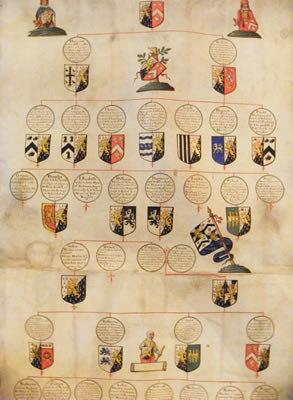 The Mostyn archive is one of the most extensive family and landed estate collections in the whole of Wales, with its extraordinary character determined by the innovations of the family and estate over centuries. Some of the items within the collection are of national significance.
The Mostyn archive is one of the most extensive family and landed estate collections in the whole of Wales, with its extraordinary character determined by the innovations of the family and estate over centuries. Some of the items within the collection are of national significance.
The chronological, geographical and subject scope and content of the archive is broad and diverse with materials ranging from the medieval period through to the 21st century. Most of the written manuscripts relating to or belonging to the family and estate are housed at the National Library of Wales, Bangor University Archive and the Flintshire Record Office in various ‘Mostyn Manuscript’ collections, though many documents of great historical relevance also remain in the possession of the estate at both Mostyn hall and Llandudno. Materials range from Welsh poetry, early printed books, last will and testaments, estate rentals, inventories and correspondence through to surveys, plans and maps, valuations, mineral records, medieval chronicles, illustrated pedigree rolls and medical recipes.
The archive also contains a plethora of visual and material culture. The two primary residences of the family at Mostyn and Gloddaith, complete with their surrounding estates, survive as remarkable inspirations for architectural and landscape historians. Mostyn and Gloddaith halls also continue to physically enshrine a rich array of the family’s material paraphernalia including the famous silver eisteddfod harp, a complete collection of family portraits dating from the 17th century, weaponry, heraldic displays, family heirlooms and fine examples of furniture. Other items of significance are held in museums throughout the world such as the ‘Mostyn Tompion’ at the British Museum and the ‘Mostyn Ewer and Basin’ at the National Museum of Wales.
Detailed catalogues of the Mostyn Manuscripts are available at:
The National Library of Wales, Aberystwyth: www.llgc.org.uk
The Flintshire Record Office, Hawarden: www.flintshire.gov.uk/archives
Bangor University Archive: www.bangor.ac.uk/archives
The Mostyn Project
The ‘Mostyn Project’, supported by Mostyn Estates Ltd. and the Mostyn family, is an initiative of the Institute of Medieval and Early Modern Studies at the Universities of Aberystwyth and Bangor. Launched in September 2009, its focus is the vast, varied and fascinating body of records – both written and material – that were generated, collected, or at some point owned by the Mostyn family and estate.
The Mostyn Project’s key objectives are:
- To raise public and academic awareness of the range and interest of the Mostyn material.
- To enhance the Mostyn material as a public and academic resource through such activities as locating, cataloguing, digitising, electronically disseminating, restoring and exhibiting it.
- To demonstrate the usefulness of the material for the public and academic understanding of past and contemporary cultures – particularly those of Wales – through research projects, exhibitions and lectures centred on the records of the Mostyn family and estate.
As part of the project, Mostyn Estates Ltd. is sponsoring and supporting the PhD research which is currently being undertaken by Shaun Evans between Aberystwyth and Bangor Universities. A History graduate from the University of York, Shaun has lived on the estate at Tre-Mostyn all his life, his father having worked as a forester at Mostyn hall for over twenty-five years. His research is focused on the Mostyn family during the 16th and 17th centuries and revolves around concepts of dynasty and identity; essentially concerning how the family created and maintained their power, status and authority across the period. During the course of his research Shaun has delivered numerous talks and presentations focused on the history of the family and estate, in both Flintshire and the Llandudno area. In the summer of 2011 he jointly organized a successful one-day conference at Gloddaith hall (St. David’s College) focused on the researching of Welsh families and their archives c.1500-1850.
Other stands of postgraduate research currently taking place under the umbrella of the Mostyn Project include Sam Garland’s study of a collection of political newsletters written from London to Sir Thomas Mostyn at Gloddaith during the late 17th century and the production by Eirian Jones of a new Welsh language edition of the vast corpus of praise poetry addressed to the family. Also under development are two major projects, one concerning the development of Llandudno as a significant urban community and coastal resort and the other investigating the possibilities for using digital humanities methods to reconstruct the Mostyn Library.
For further information see: www.imems.ac.uk/mostyn.php
